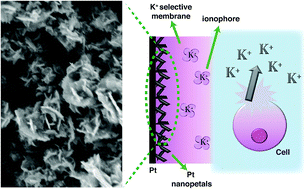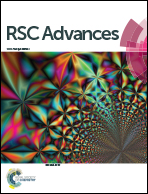Platinum nanopetal-based potassium sensors for acute cell death monitoring†
Abstract
Growing interest in the role of ions as cell death regulators has led to the consideration of K+, which plays a major role in events such as necrosis, apoptosis and osmotic shock. These mechanisms induce effluxes of K+, which can be measured to monitor such cellular events. In this work, we present a fast and simple template-free electrodeposition method for modifying electrodes on microfabricated Si-based platforms with Pt nanopetals. K+-selective electrodes were constructed by coupling such newly obtained Pt nanopetals, which were used as a solid contact, with PVC (polyvinyl chloride) K+-selective membranes. The drift over time was reduced by three orders of magnitude from several mV h−1 for bare electrodes to tens of μV h−1 when Pt nanopetals were used as an intermediate layer between the electrode and the selective membrane. The improved potential stability is comparable to the best values obtained by using solid-contact ion-selective electrodes based on other nanomaterials. The sensors exhibited near-Nernstian behavior and high selectivity for K+. By studying cell viability in relation to K+ measurements, we established a new correlation between the level of ions and the cell viability upon exposure to both osmotic shock and treatment with acetaminophen. The present method for the continuous and non-invasive monitoring of cell death in a bioreactor has potential applications in various biomedical domains.



 Please wait while we load your content...
Please wait while we load your content...